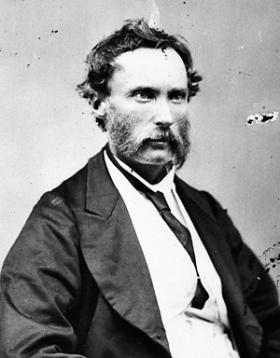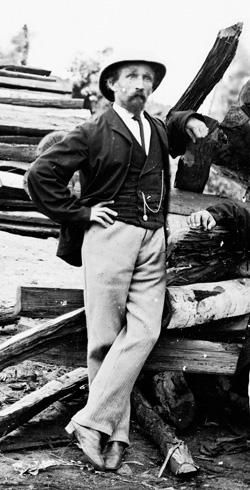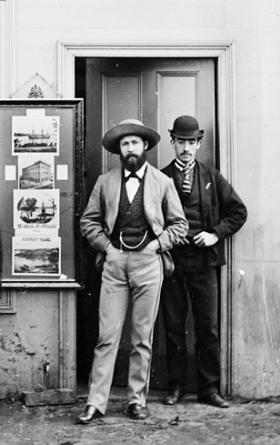Holtermann and the A&A Photographic Company
We recently received a comment about authorship of the Holtermann Collection.
Although it may seem a purely historical quirk that the photographic negatives acquired by the Library in 1951 should be called the Holtermann Collection (because they were found in his daughter-in-law’s garden shed), there are other reasons the name should remain. At no time has the Library ever suggested Holtermann took the photographs. The photographers of the glass negatives held in the Library at ON4 include Henry Beaufoy Merlin, Charles Bayliss and Augustus Clinton of the American and Australasian Photographic Company. Additionally a small number of personal stereoscopic negatives by Holtermann himself are included at the ON4 call number.
I last wrote about the A&A Photographic Company in Eye for Photography, published by Miegunyah Press in 2004. It gives the gist of Merlin’s contribution, although more recent research is able to be more specific about certain dates and even the authorship of particular negatives. What I wrote then was;

"Our readers were doubtless somewhat surprised to notice in our last Friday’s issue that the American and Australian Photographic Company intended “to photograph every house in Yass.” Unusual as was that announcement, next morning proved that it was seriously made, for Mr. Merlin, the representative of the company, was all that day busily engaged taking the photographs. The work is done rapidly, and to judge by specimens we have seen it is done with more than usual excellence. A large number of the buildings have already been taken, and yesterday afternoon Rossi-street was being transferred to the plates. Mr. Merlin also intends to take a view of the town from near Mr. Laidlaw’s residence. The question with most persons will be, what object has the company in view, seeing that their representative does not press the sale of photographs in any way, although they are procurable at a very moderate cost? By stating what has been done in Victoria we will solve the problem. Every building of any importance in every town in Victoria has already been taken, and very carefully arranged and displayed at the company’s offices, so that if an insurance or an investment is desired to be effected, or any other object in which the importance or knowledge of the actual appearance of the town would be an advantage, the necessity of a personal visit is rendered unnecessary, as a call at the company’s rooms will just as well secure the object in view. To afford this information, the company charges a small fee, we believe one shilling. Having completed the neighbouring colony, the company purpose extending their operations to New South Wales, and we understand Yass (owing to Mr. Merlin desiring to rest his horses for a few days before resuming his journey to Sydney) has the advantage of being the first town taken. As several photographers will shortly be at work in the various towns, the company’s offices in Barrack-street, Sydney will shortly become one of the “sights” of the Metropolis." [1]
Essentially, the American & Australasian Photographic Company had established a carte-de-visite library of cities, towns and residences - an image bank of the colony, from which reproductions could be purchased.
When they arrived in Sydney in September 1870, Merlin and Bayliss advertised that in the previous two years they had photographed ‘almost every house in Melbourne, and the other towns in Victoria’. Further, they had just photographed ‘all Yass, Braidwood, Queanbeyan and Goulburn, and, 800 views of Parramatta alone’. [2] They were aware that their venture was unusual and contemporary advertising by the American & Australasian Photographic Company reflects a considered understanding of the photographic medium and an intellectual approach to their work.
The A. and A. Photographic Company desire further to remind the public that these negatives are not taken for the mere immediate object of sale, but that being registered, copies can at all times be had by or of those parties residing in any part of the colonies wherever the company’s operations have extended, thus forming a novel means of social and commercial intercourse. [3]
The company’s photographs were distinctive, in that they captured groups of people casually standing outside their shops and residences. Some were owners or employees; others were just passers-by. Whether this was intentional or not, the technique of including bystanders would have maximised the number of potential purchasers.
They also opened a traditional portrait studio in Sydney and in a special promotion offered each sitter a chance to enter their grand Gratuitous Photographic Art Distribution. Prizes were albums of cartes-de-visite views of the colony and larger format views of Sydney, “worth over 200 pounds.” [4]
Nevertheless, it is not surprising that Merlin and Bayliss headed west in 1872 with the new gold rushes. The cry “Rush-O!” meant money for businesses, including photographers. A studio for the A&A Photographic Company was built on land owned by Bernard Otto Holtermann in Hill End and excursions were made to surrounding areas by horse drawn caravan.

Merlin and his assistant Bayliss had already photographed some of the gold producing towns of the colony and Holtermann’s patronage enabled them to continue the undertaking, using a larger camera.
Tragically, Merlin fell ill and died from pneumonia in September 1873, leaving his assistant the task of documenting towns for Holtermann’s Exposition. Consequently, Bayliss toured Victoria the following year, but returned to Sydney in 1875 and began making giant panoramas of the city from the tower of Holtermann’s house in North Sydney. The venture was to cost Holtermann over 1000 pounds, but resulted in the production of the world’s largest wet-plate negatives and several panoramas. One measuring 10 metres long impressed audiences overseas and received the Bronze award at the Philadelphia Centennial Exhibition of 1876 and a Silver Medal at the Paris Exposition Universelle Internationale in 1878.
Only a small percentage of the A&A Photographic Company’s output has survived, but 3,500 small format wet plates negatives (including extensive coverage of the towns of Hill End and Gulgong) and the world’s largest wet plate negatives, measuring a massive 0.97 x 1.60 metres, are held by the State Library of New South Wales.“
Since that account was written, photo historian Marcel Safier and I have established that Merlin first undertook photography in Victoria in 1864 (not 1866), becoming bankrupt the following year. Interestingly, Merlin retired as manager of the NSW branch of A&A Photographic Company in February 1872 and sold the business to Andrew Carlisle. Unfortunately, Carlisle sold all the view negatives of the company in September 1872, so it seems all the views taken throughout Victoria and NSW by Merlin and Bayliss in 1870 and 1871 were destroyed at that time.
In the meantime, Merlin and Bayliss went to Hill End in March 1872. Shortly afterwards, they were commissioned by Holtermann to take photographs. This did not take place in January 1873 (with the announcement of Holtermann’s great International Travelling Exposition), or even with the discovery of the world’s biggest big gold specimen in October 1872 (when Holtermann’s wealth increased), but much earlier, judging by this extract from the Gulgong Guardian 13 June 1872.
"Photographic Company in Gulgong
The American and Australasia Photographic Company who have been taking photographs of the town, businesses and mines, intend to go to Canadian Lead and Home Rule shortly to continue their work. Messrs Merlin and Bayliss have been commissioned by Bernard Holtermann of Hill End to photograph the goldfields of Hill End and Gulgong. They will return to Gulgong after they have completed their photography in the suburbs.

We continue to use the term Holtermann Collection to distinguish those negatives from the large number of images taken by A&A before 1872. Photographers Merlin, Bayliss (pictured left with Clinton to his right) and studio operator Henshaw Clarke were responsible for those. However, Bayliss’s contribution before 1872 should not be overlooked. We know for instance that he was the photographer of all Illawarra views in May 1871, as Merlin was unable to leave Sydney. [6] Bayliss also took all photographs during Merlin’s absence as photographer for the Royal Society of Victoria’s Solar Eclipse Expedition to Cape York from Nov 1871 to Jan 1872.
Certainly, most of the large format negatives we have at ON4 can be dated after Merlin’s death. In fact, Holtermann specifically employed Bayliss to carry on photographing for his Exposition and wrote about this in a document held by the Library. (Note that Holtermann writes in the third person and uses an old-fashioned long ‘s’: represented here as follows “∫”)
“He also started by the idea of a friend, four years ago (Mr Beaufoy Merlin) to take views and Photographs of the different Parts of this colony and at the same time to collect all information pos∫ible in reference of Resources & Population of the different Districts to inable [sic] him at some future day to make a Grand show in the European Countries, but Since Mr Merlin died suddenly, he engaged Mr Charles Baylis∫ of Melbourne formerly with Mr Merlin and we are proud to state that he has turned out to be as good a Photographer as the following discription [sic] will show. Mr Holtermann has now on hand, some 1000 negatives of different Views in the Colony such as Sydney, Bathurst, Orange, Dubbo, Hill End etc etc and in our Sister Colony Victoria, Melbourne, Ballarat, Bendigo or Sandhurst, Pleasant Creek, Castlemaine etc etc and for the finishing Touch he has taken with Mr Baylis∫ a splendid Panoramic View of the whole of our City & Suburbs, Harbour and North Shore on direct Negatives of 18x22 inch forming a length of 33 feet…” [7]
Some of the earlier views of Victoria and NSW taken by Merlin and Bayliss of the American and Australasian Photographic Company exist as original prints throughout the Library’s collection. Interestingly, in 2001, an album of 234 CdV views of country NSW by A&A was donated to the Library, which seems to be part of the second prize in their Gratuitous Photographic Art Distribution Prize of 1871. We have catalogued it at PXA 933 under the authorship of A&A.
We even have a few CdV views taken by Merlin under his own name before the formation of the American and Australasian Photographic Company. They bear the simple imprint MERLIN on the front.
Photographic historian Marcel Safier and I have unearthed a large amount of material about Merlin, which we will publish when the Holtermann Digitisation Project is complete.
Alan Davies
[1] Yass Courier 18 Feb 1870, also Queanbeyan Age 24 Feb 1870
[2] Sydney Morning Herald 21 September 1870
[3] ibid
[4] Sydney Morning Herald 12 May 1871
[5] For an account of `Holtermann's Exposition' by the photographer, Beaufoy Merlin, see Town and Country Journal, 27 Sept 1873.
[6] Sydney Morning Herald 6 May 1871
[7] Holtermann Papers ZML MSS 968